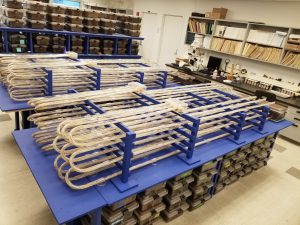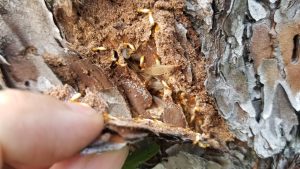
How do some of the most voracious subterranean termite species live and remain active around a house? They have a knack for “smelling death.”
In the United States, there are two primary ways to protect a house from subterranean termites: non-repellent liquid termiticides or baits. A groundbreaking study from the University of Florida Institute of Food and Agricultural Sciences (UF/IFAS) reveals the limitations of some liquid insecticides in eliminating subterranean termite colonies.
Scientists at the UF/IFAS Fort Lauderdale Research and Education Center (FLREC) studied the efficacy of non-repellent termiticides, which have been used for more than 20 years. The study, just published in the Journal of Economic Entomology, raises concerns about the continued use of liquid control methods.
They show a limitation on the efficacy levels for controlling colonies of subterranean termite species that are prevalent in the southern United States.

“While liquid termiticide treatments can provide levels of protection against subterranean termite populations, and effectively prevent damage in structures, the colonies in the ground surrounding the structure are not really impacted much, postponing the potential damage they can create in time,” said Thomas Chouvenc, associate professor at FLREC.
In the study, Chouvenc showed subterranean termites foraging over long distances in soil treated with a commonly used non-repellent termiticide would rapidly die near the treatment, leading to an accumulation of dead termites.
“Such an area of dead termites, referred as the ‘death zone,’ creates a situation where the rest of the colony avoids it due to the smell of death,” Chouvenc said.
The study demonstrated that the “death zone” spreads up to 2.56 meters or up to 8 feet, 4 inches from the treatment area, preventing overall termite activity within that zone over time. Meanwhile, the study showed that as little as 1.5 % of the termite colony population was impacted by the treatment, allowing the termite population to maintain their long-term potential for damage within the area.
“Effectively, while such liquid termiticides are technically non-repellent to subterranean termite foragers in their formulation, they become functionally repellent in their application, as a result of the early mortality onset of foragers around the treated area,” as said by Chouvenc in his study.
Subterranean termites can forage for several hundred feet underground and can avoid areas that are detrimental to them, said Chouvenc. With millions of individuals, colonies can complete their life cycle and continue to produce future generations of termite colonies within the affected communities.
Some in the pest control industry have taken notice, he said.
“We already had elements of evidence that secondary repellency was at play since 2005, but there has been a long reluctance from the industry to accept it,” said Paul Kelly, an Alabama pest control provider not involved with the study. “The data provided by this study is rather compelling: Liquid termiticides have little impact on large subterranean termite colonies. It’s a band-aid.”
In comparison, the use of termite baits against subterranean termite species can result in colony elimination with a fraction of the environmental damage, when compared to liquid termiticides, regardless of the foraging distance, Chouvenc said.
Some pest control industry providers have been offering the use of both liquid termiticides and baits against subterranean termites over the past few years. They assume it would kill the termites close to the house, fast, with the liquid termiticide treatment, while protecting the area in the long term with bait stations in the ground.
“While this practice first appears intuitive, the result of the study raises new concern on its potential cost-effective approach,” Chouvenc said. “The existence of the death zone now implies that placing bait stations within a short distance from the liquid termiticide treatment may negate the ability of the termites to access the bait station because of the avoided death zone. I hope to be able investigate this concern in a future study.”
– 30-
by Lourdes Mederos, rodriguezl@ufl.edu
ABOUT UF/IFAS
The mission of the University of Florida Institute of Food and Agricultural Sciences (UF/IFAS) is to develop knowledge relevant to agricultural, human and natural resources and to make that knowledge available to sustain and enhance the quality of human life. With more than a dozen research facilities, 67 county Extension offices, and award-winning students and faculty in the UF College of Agricultural and Life Sciences, UF/IFAS brings science-based solutions to the state’s agricultural and natural resources industries, and all Florida residents.
 0
0
